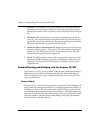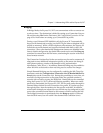
Chapter 1: Understanding ISDN and the Express XL/XLT
12 Express XL/XLT User Manual 61200.070L1-1
2. IP Router: The Express XL/XLT can function as an IP router using the
Routing Information Protocol (RIP) for advertising and learning routes
among other routers. Static routes may also be entered into the routing ta-
ble.
3. IPX Router: IPX routers and services can be exchanged between the Ex-
press XL/XLT and other devices using RIP and Service Advertising Pro-
tocol (SAP). Watch dog serialization filtering and spoofing can permit the
ISDN to be idle during no application traffic periods.
4. Network Address Translation (NAT): Single networks can connect to the
Internet with this function. The Express XL/XLT translates outgoing IP
packets over the ISDN to the IP router at the Internet Service Provider.
Popular Internet applications are supported.
5. POTS: The POTS interface can be used for interfacing to dual tone multi-
frequency (DTMF) analog devices such as telephones, modems, fax ma-
chines, etc. The Express XLT POTS option is available on part number
1200070L2 only.
Demand Routing and Bridging with the Express XL/XLT
The Express XL/XLT is a dial-up ISDN IP Router and Transparent Learning
Bridge that provides Dial-On-Demand and Dynamic Bandwidth Manage-
ment. Its features can be easily configured and used once several basic con-
cepts are understood.
Factory Default
The Express XL/XLT comes from the factory configured for MAC Bridging, IP
routing and IPX routing with no filters or connection information defined. An
IP address of 10.0.0.1 with a network mask of 255.255.255.0 is preloaded. Dy-
namic Bandwidth Management features are disabled. Although dynamic as-
signment of a B-channel for the analog (POTS) port on the Express XLT model
is always available, link idle time-out and adding/removing of B-channels
based on traffic is initially disabled.


















